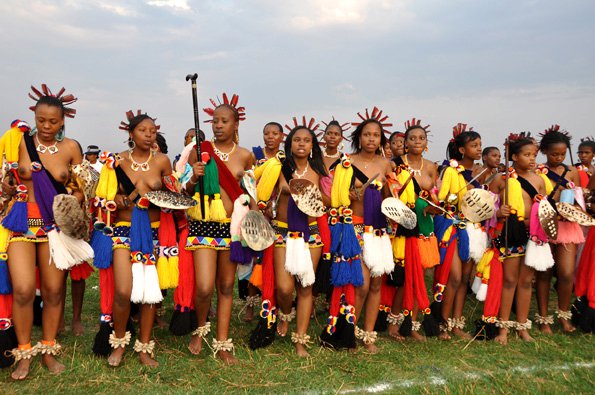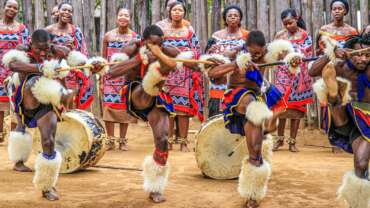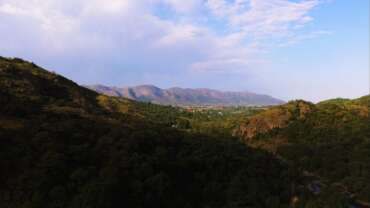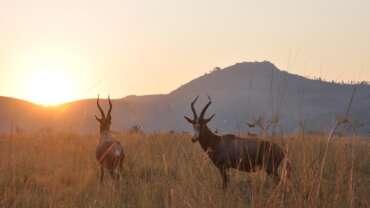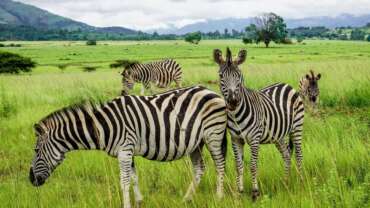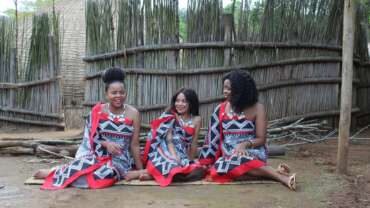South East Eswatini (Swaziland) - Wildlife Up Close
As with the North East, this region of Eswatini (Swaziland) lies largely in the lowveld. There is only scattered settlement, with one large town of note, Big Bend. A number of sugar estates are irrigated from the country’s main river, the Usuthu.
This corner of the country is home to two game reserves, one of which is widely regarded as Eswatini’s best. It is also the location for one of the country’s top adventure activities – white water rafting on the Usuthu River.
Mkhaya Game Reserve offers a case study of the challenges involved in African conservation and stands as a beacon of what can be achieved, safeguarding a shrinking natural environment in the face of burgeoning human pressures, after a history of uncontrolled exploitation. Home to a variety of big game and with just one intimate but excellent camp, it now offers some of the best rhino experiences found in the whole of Africa. Nisela Game Reserve also offers game viewing and other activities on an area of acacia savannah.
Where to Go in South East Eswatini
Great Usutu River & Big Bend
The Great Usuthu is the largest river in Eswatini (Swaziland). It enters the country on the western border with South Africa and leaves through the Lubombo mountains east of Big Bend for its final journey to the Indian Ocean. Its lower reaches are home to hippos, crocodiles and tiger fish, while its waters are the lifeline for Eswatini’s sugar estates. Swazi Trails in the Ezulwini Valley offers full-day and half-day river rafting trips on a remote stretch of the Usuthu, where the river thunders through wild gorges and meanders through rural communities. Rafters will see impressive rock stacks, riverbank life and a fair amount of wildlife – including the odd small crocodile. They will also get drenched: for most of the year this is a Grade III (medium difficulty) rafting river, but in full flow some sections can rise to Grade V and even VI.
Big Bend lies 80km south east of Manzini on the MR8. Built to serve the sugar industry, it is a regional centre for south east Swaziland. Emerald-green cane fields have supplanted the dusty bush, and visitors will find shops, services and a handful of places to stay. From Big Bend the road continues south over the Lavumisa border into South Africa and joins the main highway south to Durban
KaMsholo Bushveld Safaris
The private KaMsholo Bushveld Safaris south of Big Bend protects a picturesque tract of 4000ha of acacia savannah beneath a craggy Lubombos backdrop. These wild hills harbor some unusual habitats, with flora and fauna found nowhere else in the country. The reserve’s graded dirt roads are fine for small vehicles and with no dangerous game, visitors can explore trails on foot, guided or un-guided. Wildlife includes plentiful giraffe, plus zebra, blue wildebeest, greater kudu, nyala, impala, common reedbuck, common duiker and warthog and other game. Among the rich reptile fauna are some large pythons and there are crocodiles in the large dam to the south, where catch and release fishing is available. Birders will delight in the more than 300 species recorded around here. Raptors are especially impressive. There is a range of visitor facilities at the entrance to the reserve, including a good restaurant, playground, campsite and curio shop, and there is a choice of accommodation including traditional beehive huts.
Mkhaya Game Reserve
Mkhaya Game Reserve, a private reserve, located between Manzini and Big Bend, is Eswatini’s (Swaziland’s) most exclusive safari retreat. Here you leave your vehicle behind to join an expert private guide for game drives and bush walks. You then dine beneath the stars, before drifting off to sleep in your chalet to the noises of the night.
Big Game Parks acquired Mkhaya in 1979 in order to protect the country’s last indigenous Nguni cattle. As the reserve expanded so did its ambitions. Today it is a sanctuary for endangered species and home to other large mammals that once roamed Eswatini freely. White rhinos are common and black rhinos, though more elusive, are still often seen. You should also find giraffe, zebra, hippo and warthog, plus Eswatini’s only herd of buffalo. Roan, sable and tsessebe are among the rarer antelope, with wildebeest, kudu, impala and nyala all abundant. Leopards are only occasional visitors, but you may hear spotted hyenas at night and crocodiles are often seen lounging around the main waterhole. Back in camp the excellent birdlife includes such specials as narina trogon, pink-throated twinspot and crested guineafowl, while nyala and even a few shy suni browse around the camp. After dinner listen for the fragile whistle of fiery-necked nightjars, the unearthy shriek of greater bushbabies and the whoop of spotted hyenas.
Tracking rhinos on foot at Mkhaya is as thrilling as anywhere in Africa. White rhinos are generally approachable and the guides may take you extremely close. Black rhinos are more nervous and aggressive, so tracking them can be an adrenaline-charged affair. Bush walks are not just about big game, but offer a full immersion in the sights, sounds and textures of the bush. Expect to learn about everything from the air-conditioning of a termite mound to the contents of a hyena’s droppings. Afterwards, watching wildlife from a vehicle may seem like watching it on TV.



